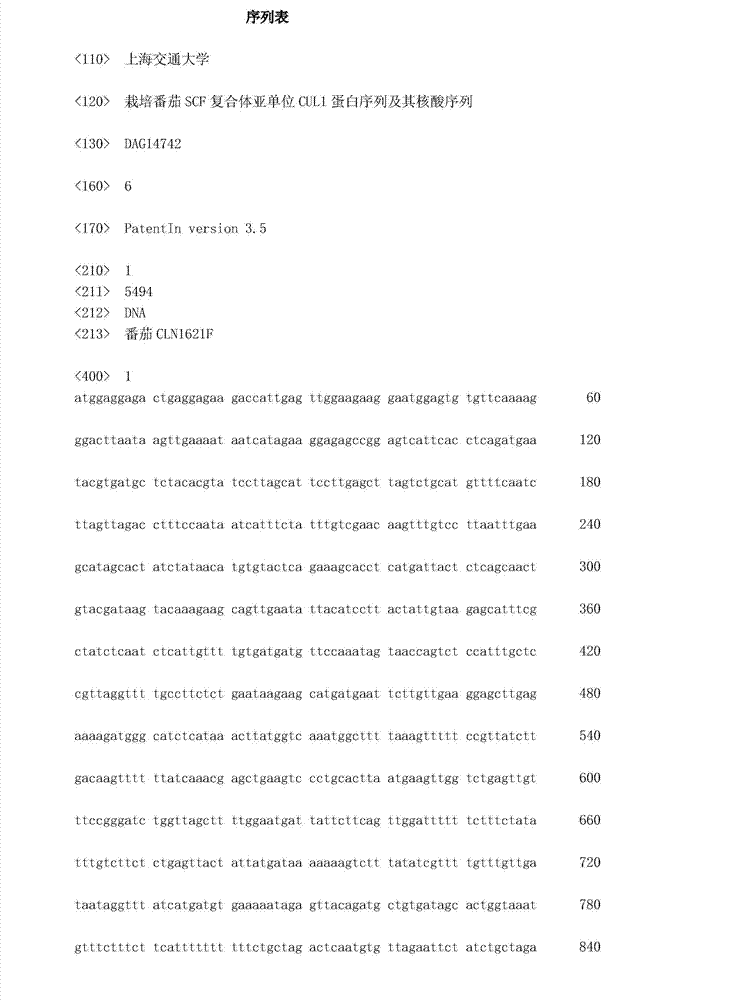Cultivated tomato SCF complex subunit CUL1 protein sequence and nucleotide sequence thereof
A protein sequence and nucleic acid sequence technology, applied in the field of molecular biology, can solve problems such as undiscovered technical topics
- Summary
- Abstract
- Description
- Claims
- Application Information
AI Technical Summary
Problems solved by technology
Method used
Image
Examples
Embodiment 1
[0038] Example 1, Cloning of full-length cDNA of tomato SCF complex subunit CUL gene
[0039] 1. Preparation of tomato materials
[0040] Cultivated tomato with self-compatibility (in this case, CLN1621F is selected as the material, which can be obtained from public sources, such as the Asian Vegetable Research and Development Center AVRDC ( http: / / avrdc.org / ) Provided, (Costa, C.A.d., Silva, A.C.d., Sampaio, R.A., etc., Productivity of determinate growth tomato lines tolerant to heat under the organic system[J]. Horticultura Brasileira, 2011, 29(4), pp590-593.) , the experimental materials were cultivated in the greenhouse of the College of Agriculture and Biology, Shanghai Jiaotong University, and samples were taken after flowering.
[0041] 2. Use TAKARA kit to extract RNA
[0042] (1) Weigh 0.1g flower, grind it into powder in liquid nitrogen, quickly transfer it to a 1.5ml RNA-free centrifuge tube, add 500μl lysate (containing 1% β-mercaptoethanol), and fully shake i...
Embodiment
[0057] Cloning of embodiment, 2 tomato genome SCF complex subunit CUL1 gene
[0058] 1. Extraction of tomato genomic DNA
[0059] DNA was extracted by CTAB method.
[0060] (1) Pick about 1g of the young leaflets of CLN1621F tomato plants, grind them into powder in liquid nitrogen, put them in a 1.5ml centrifuge tube, add 600μl of CTAB solution containing 2% β-mercaptoethanol, mix well and place in a constant temperature water bath at 65°C Cook in the pot for 1h-1.5h;
[0061] (2) Take the sample out of the water bath, cool it to room temperature, add 300 μl phenol and 300 μl chloroform respectively, mix well, let it stand at room temperature for 5 minutes to separate the liquid, and centrifuge at 10,000 rpm for 10 minutes;
[0062] (3) Take 500 μl supernatant in a new centrifuge tube, add 500 μl chloroform, mix gently, let stand at room temperature for 5 minutes to separate layers, and centrifuge at 12000 rpm for 10 minutes;
[0063] (4) Pipette 350 μl supernatant into a...
Embodiment 3
[0076] Example 3, CUL1 gene expression analysis in each tissue of cultivated tomato plants
[0077] 1. Extract RNA from stems, leaves, flower buds 3 days before flowering (-3DPA), flower buds on the day of flowering (0DPA), flower buds 3 days after flowering (3DPA), and fruit of CLN1621F plants; in addition, the four parts of the flower were dissected , to extract RNA from petals, calyx, anthers, and pistils, respectively.
[0078] 2. Reverse transcription to form cDNA, and design specific primers based on known sequences.
[0079] 3. Ubiquitin was used as an internal reference, and semi-quantitative PCR analysis was carried out in the form of isotube amplification.
[0080] 4. Analysis of results: from figure 1 It can be clearly seen that the expression of CUL1 gene is tissue-specific, and it is only expressed in flowers, and has no transcriptional activity in other tissues, which implies that CUL1 gene is involved in the reproductive development of flowers. figure 2 It...
PUM
 Login to View More
Login to View More Abstract
Description
Claims
Application Information
 Login to View More
Login to View More - R&D
- Intellectual Property
- Life Sciences
- Materials
- Tech Scout
- Unparalleled Data Quality
- Higher Quality Content
- 60% Fewer Hallucinations
Browse by: Latest US Patents, China's latest patents, Technical Efficacy Thesaurus, Application Domain, Technology Topic, Popular Technical Reports.
© 2025 PatSnap. All rights reserved.Legal|Privacy policy|Modern Slavery Act Transparency Statement|Sitemap|About US| Contact US: help@patsnap.com



